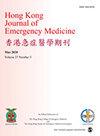韩国环境颗粒物暴露对呼吸系统疾病急诊就诊的单日和累积影响
IF 0.8
4区 医学
Q4 EMERGENCY MEDICINE
引用次数: 0
摘要
背景:随着工业化进程的推进,大气污染物的污染问题越来越受到人们的关注,特别是对呼吸系统疾病的研究也越来越多。急诊反映疾病的急性加重,而不是慢性加重。目的:本研究的目的是评估韩国环境颗粒物与急诊呼吸道疾病之间的关系。方法:纳入2018年急诊科诊断为呼吸系统疾病的患者。获取了2017年12月4日至2018年12月31日的气象因子和空气污染物数据。采用泊松回归,以每日急诊人次为响应变量,单日颗粒物浓度为解释变量。结果:共纳入4207例患者。在泊松回归分析的所有呼吸系统疾病,pm10和pm2的影响。其中5个在8日和26日前最强。65岁以上年龄组和慢性呼吸系统疾病组的滞后效应较全疾病组早。累积效应在滞后期第14天达到高峰。pm10在3天前的预测分裂点为87µg/m3, pm2在8天前的预测分裂点为37µg/m3。5 . 结论:该结果可用于预测环境颗粒物浓度升高时急诊人次的增加和医疗资源需求的增加。本文章由计算机程序翻译,如有差异,请以英文原文为准。
Single-day and cumulative effects of ambient particulate matter exposure on emergency department visits for respiratory disease in South Korea
Background: Along with the industrialization, the air pollutants have gained more attention and studies especially about respiratory diseases were conducted. Emergency visit reflects acute aggravation of disease rather than chronic exacerbation. Objectives: The objective of this study was to evaluate the relationship between the ambient particulate matter and the emergency visits with respiratory disease in South Korea. Methods: Patients diagnosed with respiratory disease in the emergency department in 2018 were enrolled. The data of meteorological factors and air pollutants between 4 December 2017 and 31 December 2018 were acquired. Poisson regression was used with daily emergency visits as the response variable and single-day particulate matter concentration as the explanatory variable. Results: A total of 4207 patients were enrolled. In Poisson regression analysis of all respiratory diseases, the effects of P M 10 and P M 2 . 5 were strongest at day before 8 and 26. Age older than 65 group and chronic respiratory disease group had earlier lag effect than the all-diseases group. Cumulative effect was peaked at 14 lag day. The split point of prediction was 87 µg/m3 before 3 days for P M 10 and 37 µg/m3 before 8 days for P M 2 . 5 . Conclusion: The results can be used to predict the increase of emergency visits and need for medical resources when the ambient particulate matter concentration rises.
求助全文
通过发布文献求助,成功后即可免费获取论文全文。
去求助
来源期刊

Hong Kong Journal of Emergency Medicine
EMERGENCY MEDICINE-
CiteScore
1.50
自引率
16.70%
发文量
26
审稿时长
6-12 weeks
期刊介绍:
The Hong Kong Journal of Emergency Medicine is a peer-reviewed, open access journal which focusses on all aspects of clinical practice and emergency medicine research in the hospital and pre-hospital setting.
 求助内容:
求助内容: 应助结果提醒方式:
应助结果提醒方式:


